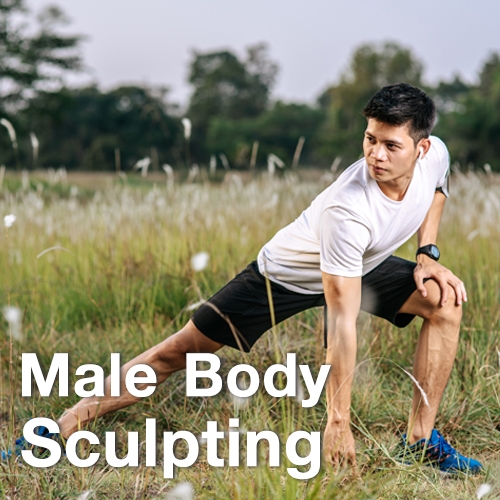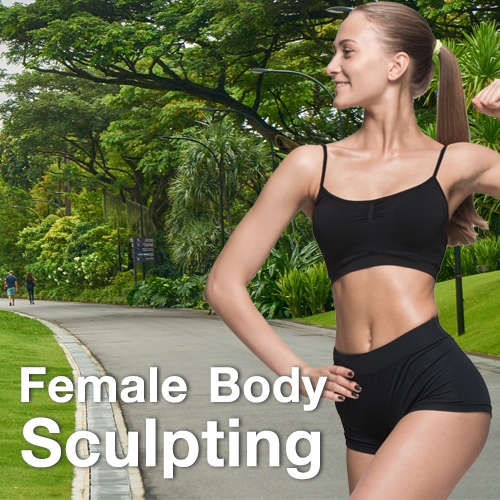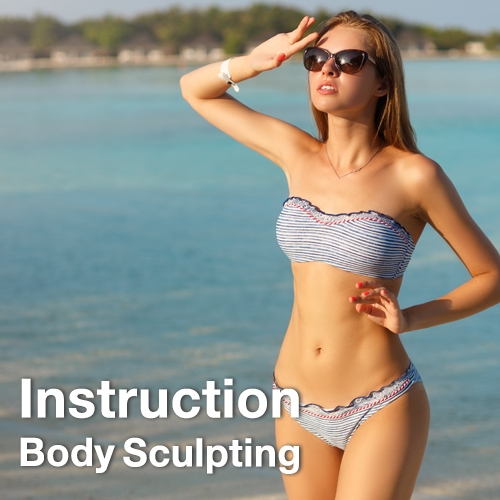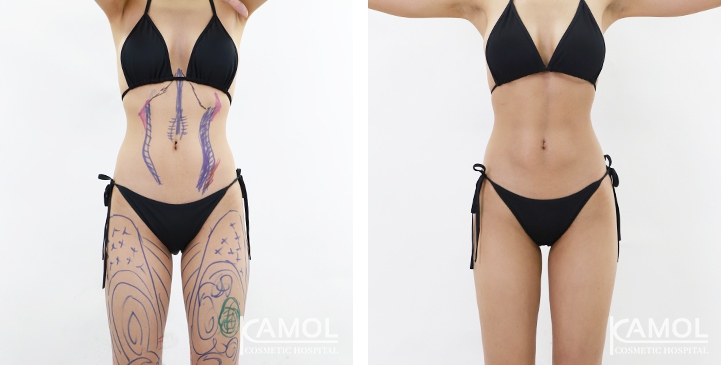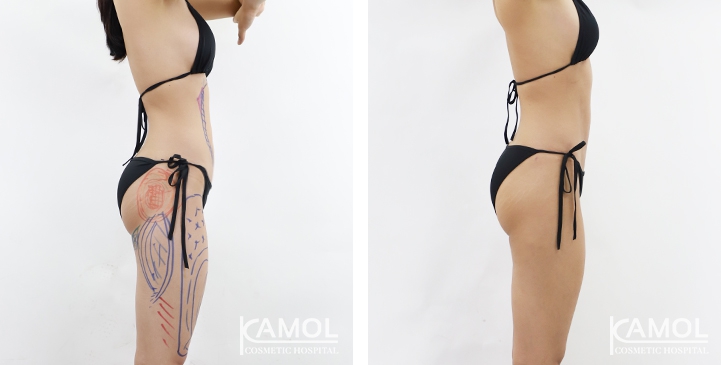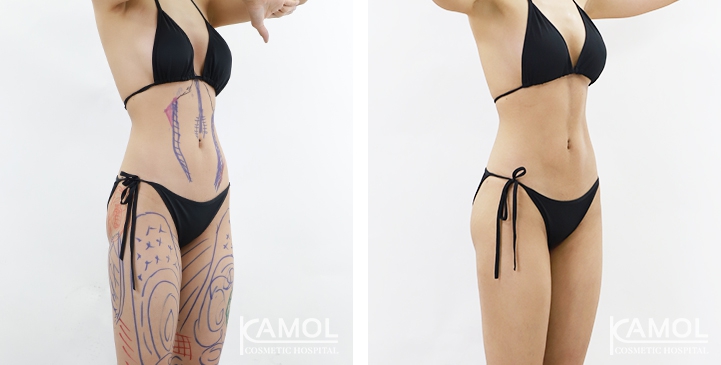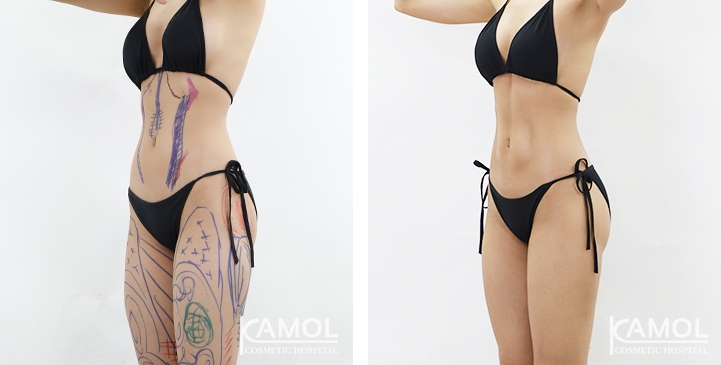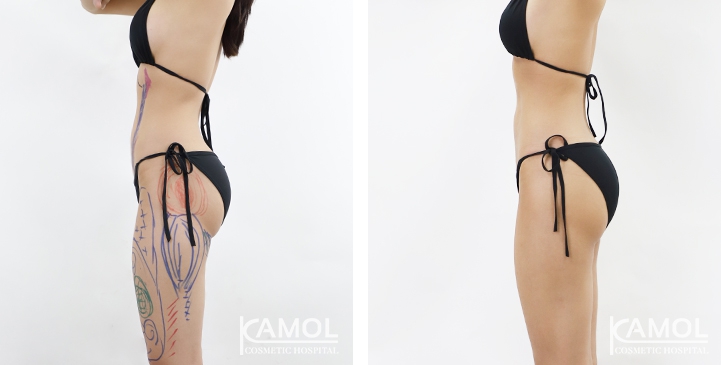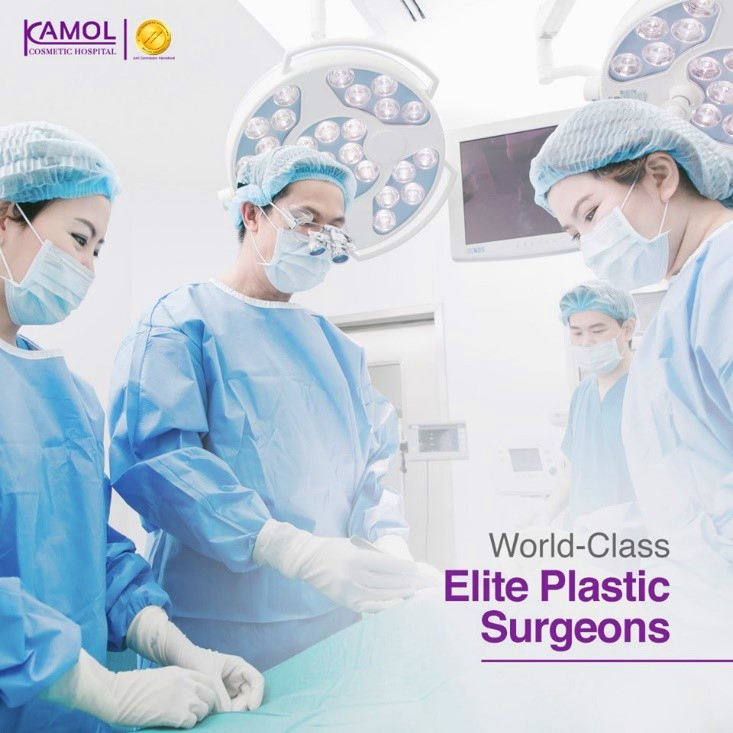Body Sculpting Surgery / Liposuction in Bangkok, Thailand
Body sculpting surgery is an aesthetic surgical procedure to reshape bodies through liposuction. The overfat areas, such as the flank, thighs, abdominals, arms, buttocks, and back, include fat grafting in some areas that need more volume. The surgeon will design and create a new body shape to balance with their structure.
We are born with different body proportions and different ways of fat distribution. In females, we can categorize them into four groups:
- I or Ruler shape: the breast, hip, and waist have almost the same proportion. The body line is more like a straight line. The fat is distributed throughout the body.
- V or Cone Shape: this body type has a broad shoulder with a small hip. Fat distribution for this type of body concentrates on the breast, shoulder, and face
- A or Spoon Shape: This body shape has small breasts and fat deposits at the waist, buttock, and thigh.
- X or Hourglass Shape: The breast and hip are the same width, but the waist is more than 9 inches smaller than the two.
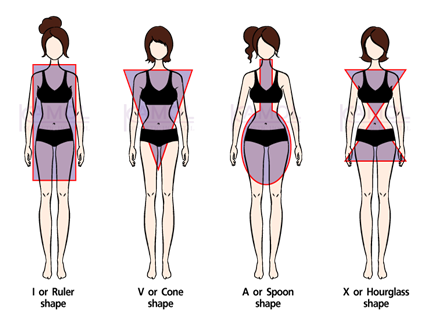
Picture 1. Shows body proportions in females.
In Males, there are three types of body proportions:
- Ectomorph: small bone, muscle, and shoulder. A small amount of fat.
- Endomorph: large bone, muscle, and a large amount of fat, but muscle was hard to visualize.
- Mesomorph: a good proportion of bone, muscle, and fat. Muscle is prominent in this body figure.
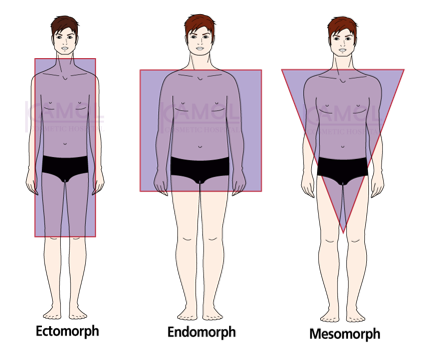
Picture 2. Shows body proportion in Male
A good candidate for Body Sculpting Surgery
- Man or woman who has not too much but prefers a perfect shape
- Healthy
- Nonsmokers
- A realistic expectation for body sculpting
- A person who has firm, elastic skin and the right muscle tone
Preparation for Body Sculpting Surgery
- Consult with the surgeon about your goal, then have a physical examination, lab test, and chest X-ray and adjust your current medication to confirm that you are available for surgery.
- Stop smoking
- Avoid taking aspirin, anti-inflammatory drugs, and herbal supplements, as they can increase bleeding
- Adjust some medication before surgery
Procedures for Body Sculpting Surgery
- Step for anesthesia: we offer sedation or general anesthesia.
- After anesthesia, the incision will be around 1 cm. The number of incisions depends on the number of areas to operate. A tumescent solution will be put in the operational areas. Traditional liposuction utilizes a hollow tube to remove the fat, and the Laser and Ultrasonic Technique uses a laser or ultrasonic energy to dissolve that fat before it is removed. Some areas need fat transfer to make more volume, and the body shape needs to be designed and created to balance the proportions.
- Close the incision by suture.
Post-operative Care for Body Sculpting Surgery
- It is usual for bloody fluid to drain on clothes and sheets for the first 24 to 72 hours after surgery. The liquid is put into the area before liposuction to make fat removal safest for you.
- A compression garment should be worn at all times except during showering. Compression garments reduce swelling and speed up your recovery. Your plastic surgeon will let you know when you can stop wearing the compression garment.
- Try to resume your routine activities at home. Light activities will also help keep fluids moving in the body and reduce swelling.
- You can shower 24-48 hours after surgery, but you need to put the garment back on, which may be difficult. Make sure you have someone to help you. When you shower, you can run soap and water over the areas without scrubbing. The surgical area should be gently dried with a clean towel.
- Avoid still (non-running) water for two weeks after surgery. Don't let the wound wet, including baths, swimming pools, hot tubs, lakes, oceans, etc.
- Postoperative massage to remove the seroma from the lymphatic system
- Routine activity is not prohibited.
- Exercise should start at around two weeks.
- Follow up on all appointments.
- Take stitches off for seven days after surgery.
Risks and Complications for Body Sculpting Surgery
- Seroma Treatment: Seroma treatment is a medical competence
- Drainage with a syringe,
- Placement of drain,
- Placement of substances like tetracycline to induce sclerosis,
- Revisional surgery to remove the seroma capsule
- Drainage with a syringe,
- Thromboembolism: Pulmonary Thromboembolism ( PTE ) is a clinical-pathological situation triggered by pulmonary artery obstruction. It is a defect of oxygen in the lungs. It is necessary to monitor a patient's vital signs and oxygen saturation.
- Infection: It detects by fever, chills, and pain.
- Anemia: This happens in these cases due to loss of blood combined with liposuction fat.
- Hematoma: a collection of blood caused by broken blood vessels.
- Fat embolism: the blockage of a blood vessel by an embolus fat.
- Laceration of the skin
- Fibrosis: the thickening and scarring of tissue
- Deformities
- Asymmetries
- Poor healing
Getting to Know for Body Sculpting Surgery / Liposuction
Male Body Sculpting Enhancing the Masculine Form
Male body sculpting is a cosmetic procedure designed to enhance the masculine...
Female Body Sculpting Enhancing the Feminine Form
Body sculpting is a cosmetic procedure that involves reshaping and contouring...
Instruction on body sculpting
We will provide a comprehensive guide to body sculpting aftercare instructions to help...
Before & After for Body Sculpting Surgery
What are the differences between Body Contouring and Body Sculpting?
Body contouring and body sculpting are often used interchangeably, but there are some subtle differences between the two terms.
Body contouring refers to a group of cosmetic procedures that aim to reshape and sculpt the body. These procedures can target specific areas of the body, such as the stomach, thighs, arms, and buttocks, and are designed to remove excess fat, tighten loose skin, and enhance the shape of the body. Examples of body contouring are liposuction, tummy tuck, and other body lift procedures.
On the other hand, body sculpting typically refers to using non-surgical techniques to shape and sculpt the body. These techniques may include cool sculpting, radiofrequency, ultrasound, and other non-invasive technologies to target and reduce fat deposits in specific areas of the body, such as the stomach, thighs, and arms.
Body Contouring refers to surgical procedures that reshape and sculpt the body. In contrast, Body Sculpting refers to non-surgical procedures that use technology to shape and sculpt the body. Both are used to improve the shape and appearance of the body, but they use different methods to achieve their goals.
What is the difference between Lipectomy and Liposuction?
Lipectomy and liposuction are surgical procedures used to remove unwanted fat from the body, but they are different procedures with distinct characteristics.
Liposuction, also known as lipoplasty, is a cosmetic procedure that uses a cannula (a thin tube) to suction out unwanted fat from specific areas of the body. Liposuction can be performed on a variety of areas, including the stomach, hips, thighs, buttocks, arms, and neck. It's performed under general anesthesia and usually requires small incisions in the targeted areas.
Lipectomy, also known as excisional liposuction, is a surgical procedure that removes large amounts of fat and skin. It's generally used in cases of significant weight loss, where there is excess skin and fat that cannot be removed by liposuction alone. This procedure is typically performed under general anesthesia and involves making larger incisions to remove the excess fat and skin. Lipectomy is often used to remove the excess skin and fat from the stomach, thighs, and buttocks and is a more invasive procedure than liposuction.
In summary, liposuction uses suction to remove unwanted fat from specific areas, while lipectomy removes excess skin and fat from the body, typically in cases of significant weight loss. Lipectomy is more invasive than liposuction.


